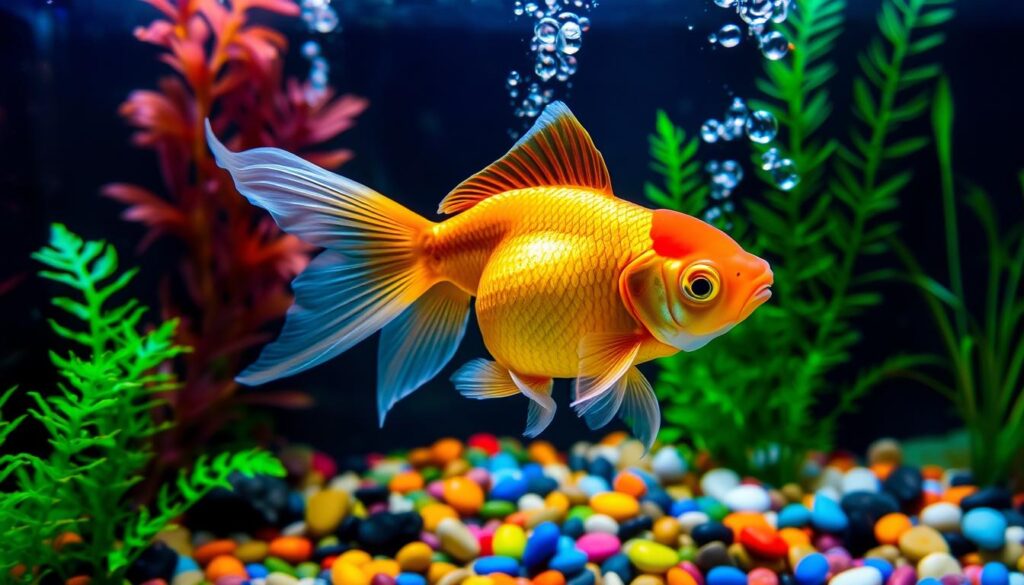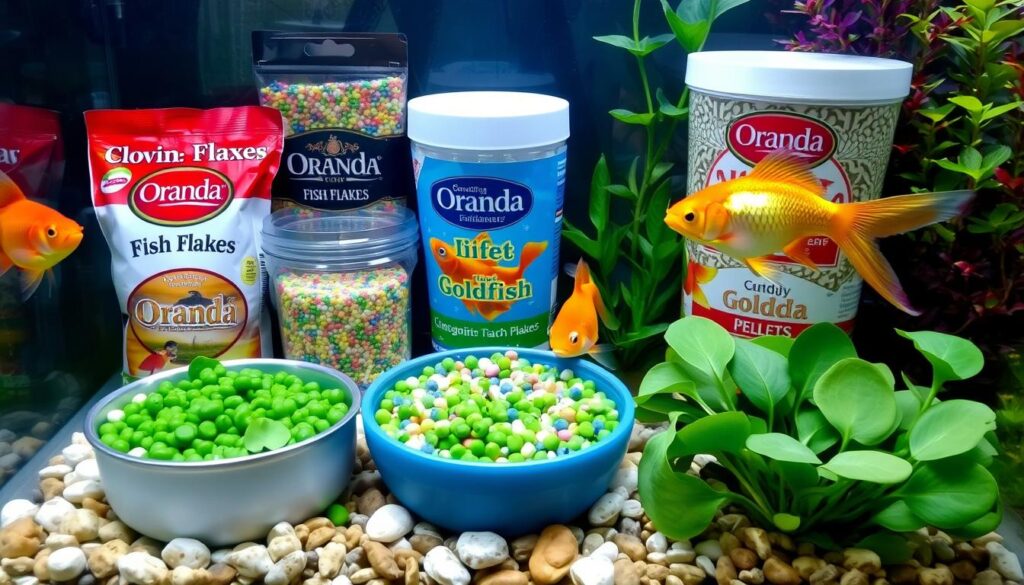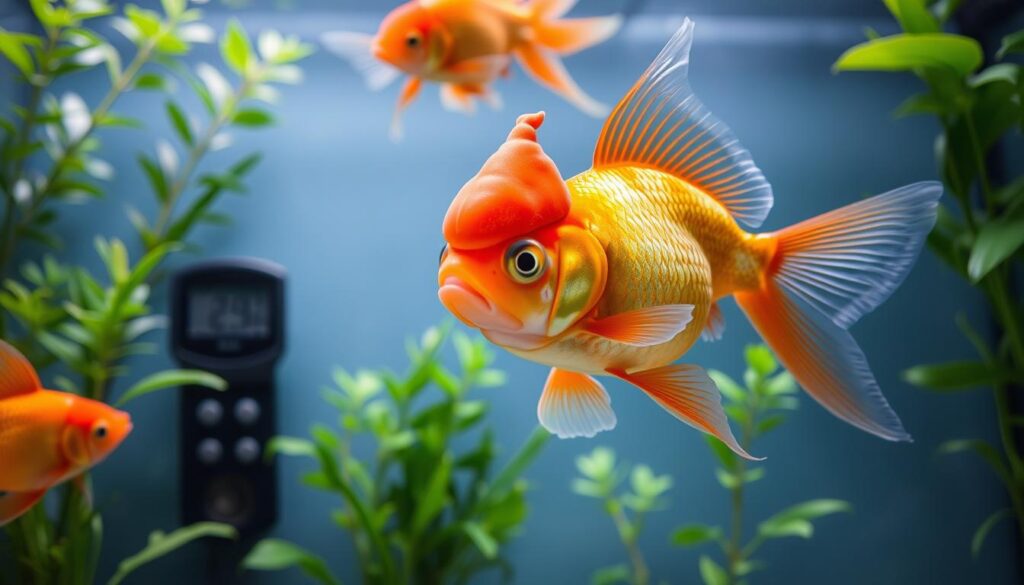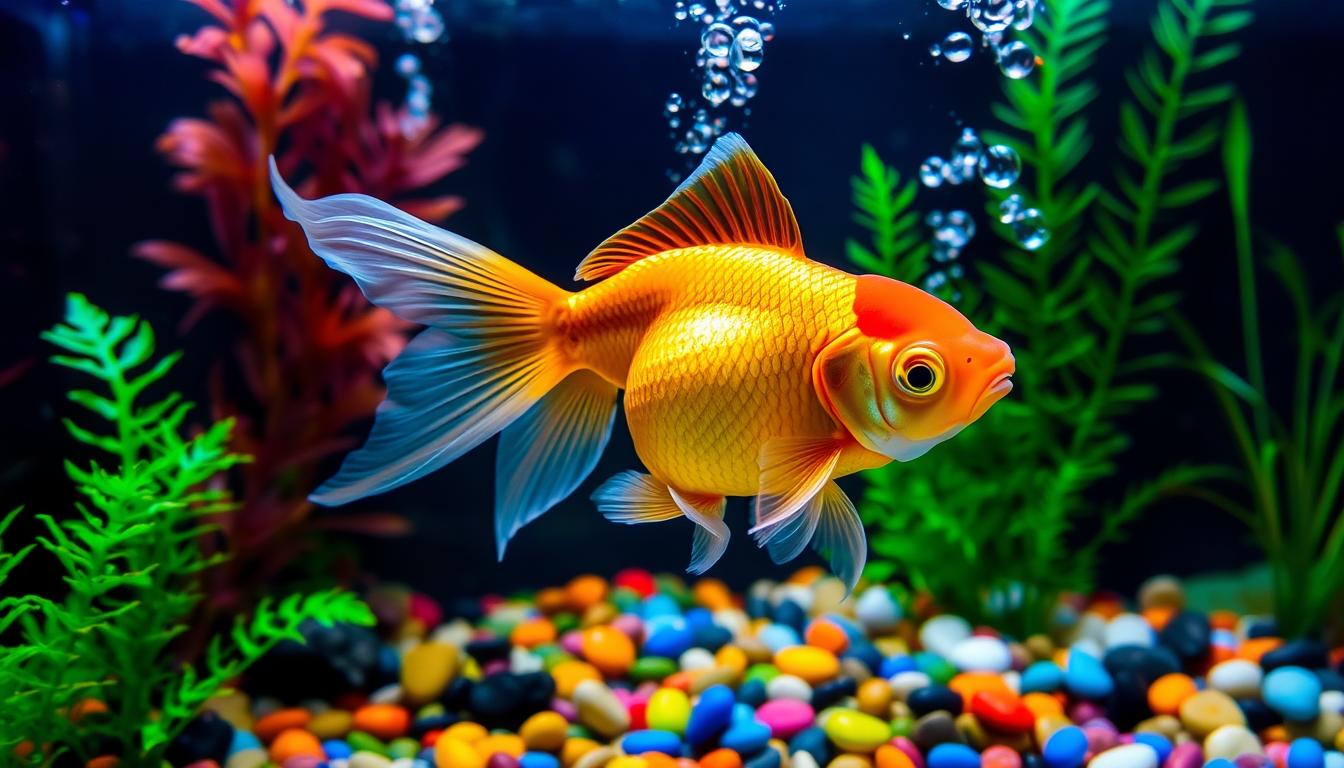
Explore the magical world of oranda goldfish, a stunning fancy goldfish variety. They are known for their unique “wen” or head growth. This makes them a standout in any home aquarium. Bred in China, they are now a favorite among both new and seasoned fish keepers.
Oranda goldfish have special physical traits and care needs. They can grow up to 7-10 inches long. With the right care, they can live 10-15 years, becoming a long-term friend for aquarium enthusiasts.
Table of Contents
Introduction to Oranda Goldfish
Explore the fascinating world of oranda goldfish. These fancy goldfish have captivated aquarium lovers for centuries. They are famous for their unique head growth, making them a favorite in home aquariums.
Origin and History
The oranda goldfish comes from ancient China. There, selective breeding turned regular goldfish into stunning ornamental fish. They were highly valued by Chinese nobility during the Ming Dynasty.
- Originated in China during the 15th century
- Carefully bred for unique physical characteristics
- Considered a symbol of prosperity and good fortune
Physical Characteristics
Oranda goldfish are known for their distinctive wen, a head growth that looks like a raspberry. They have egg-shaped bodies and come in many bright colors.
| Characteristic | Details |
|---|---|
| Body Shape | Egg-shaped, rounded |
| Head Growth (Wen) | Develops fully around 2 years of age |
| Oranda Goldfish Size | 8-12 inches when fully grown |
Typical Lifespan
Oranda goldfish can live a long time with the right care. They usually live between 10 to 15 years. Some may even live up to 20 years. Good water quality, diet, and tank conditions are key to their long life.
“A well-cared-for oranda goldfish is not just a pet, but a living work of art.” – Aquarium Enthusiast
Setting Up the Perfect Tank Environment
Creating the perfect oranda goldfish tank setup needs careful planning. These fancy goldfish need a big, clean space to thrive. Knowing how to care for them starts with the right tank environment.
- Minimum tank size of 30 gallons for a single oranda
- Additional 10 gallons for each extra fish
- Well-oxygenated water with proper filtration
- Stable water temperature between 65-72°F
“A comfortable home is key to a healthy goldfish” – Aquarium Experts
Filtration is crucial for your oranda goldfish tank. You need a filter that can handle the tank’s volume at least four times an hour. For a 30-gallon tank, look for a filter with a 120 GPH flow rate.
| Tank Requirement | Specification |
|---|---|
| Minimum Tank Size | 30 gallons |
| Water Temperature | 65-72°F |
| pH Level | 7.0-7.6 |
| Filter Flow Rate | 4x tank volume per hour |
Add soft substrate and gentle decorations to your tank. Make sure they won’t harm your oranda’s wen (head growth). Smooth rocks and live plants make a natural setting and keep your goldfish mentally active.
Water Quality and Maintenance
Keeping the water clean is key for your oranda goldfish. These fancy fish need the right water to stay healthy. Knowing about water quality helps avoid health problems and keeps your fish happy and healthy for a long time.
Temperature Requirements
Oranda goldfish don’t like big temperature changes. They do best in water between 65°F and 75°F. Big changes can make them sick and weaken their immune system.
- Maintain consistent water temperature
- Use a reliable aquarium heater
- Avoid temperature variations greater than 2 degrees in 24 hours
pH and Hardness Levels
Water chemistry is important for oranda goldfish. Your fancy goldfish care guide should talk about the right pH and water hardness levels.
| Parameter | Ideal Range |
|---|---|
| pH Level | 6.5 – 7.5 |
| Water Hardness | 5 – 18 dGH |
Cleaning Schedule
Regular care is essential for oranda goldfish. Stick to a cleaning schedule to keep your tank healthy.
- Perform weekly water tests
- Change 10-25% of water every two to four weeks
- Clean filters monthly
- Use a water test kit to monitor toxin levels
“A clean tank is a happy tank for your oranda goldfish!”
Pro tip: Always use a water conditioner when performing water changes to remove harmful chlorine and chloramines.
Feeding and Nutrition

Feeding oranda goldfish needs careful attention. They are omnivorous and need a balanced diet. Knowing their dietary needs is key to their health.
Your oranda goldfish needs a varied diet. Experts suggest the following:
- Feed 2-3 times daily in small portions
- Use high-quality goldfish pellets as the primary food source
- Supplement with fresh vegetables and occasional live foods
- Avoid overfeeding to prevent health complications
Nutrition is vital for your oranda’s health. Their diet should mix protein and plant-based foods. This supports their digestive system.
| Food Type | Frequency | Nutritional Benefit |
|---|---|---|
| Goldfish Pellets | Daily | Balanced nutrition |
| Frozen Bloodworms | 2-3 times weekly | Protein source |
| Blanched Vegetables | 1-2 times weekly | Fiber and plant nutrients |
“A well-planned diet is the cornerstone of a healthy oranda goldfish” – Aquarium Nutrition Experts
Watch for signs of improper feeding, like constipation or buoyancy issues. Portion control is key. Only feed what your fish can eat in two minutes. In colder months, feed less as their metabolism slows.
Feeding oranda goldfish is more than just food. It’s about keeping them healthy and long-lived. A thoughtful nutrition plan will help your oranda thrive for years.
Oranda Goldfish Varieties and Colors
Explore the colorful world of oranda goldfish. Each variety adds its own charm to your aquarium. These fancy goldfish come in many colors and patterns, exciting any fish lover.
Oranda goldfish show amazing diversity, making them popular among aquarium fans. Let’s look at some of the most beautiful varieties:
Red Cap Oranda
The red cap oranda is a standout in the oranda family. It has a unique look with:
- A silvery-white body
- Brilliant red cap covering the head
- Elegant, flowing fins
Black Oranda
The black oranda is a dramatic choice for aquariums. It’s a mix of black moor varieties, known for:
- Deep, rich black coloration
- Smooth, velvety appearance
- Unique genetic heritage
Calico Oranda
The calico oranda offers a detailed color pattern. It has:
- Mottled coloration with multiple hues
- Patches of orange, white, and black
- Unpredictable and beautiful color distributions
“Each oranda goldfish variety tells a unique story of genetic diversity and aquatic beauty.” – Aquarium Enthusiast
When picking your oranda goldfish, think about each variety’s traits. The best choice depends on your taste and aquarium setup.
| Variety | Primary Color | Unique Characteristics | Price Range |
|---|---|---|---|
| Red Cap | White/Red | Bright red head growth | $35-$75 |
| Black | Black | Deep, uniform coloration | $50-$100 |
| Calico | Multi-colored | Unique color patterns | $40-$125 |
Pro tip: Each oranda goldfish variety needs special care to keep its colors bright and health good. Do your research before choosing!
Health Issues and Prevention
Keeping your oranda goldfish healthy means being proactive and observant. Knowing about health problems is key to avoiding serious issues. This is part of caring for your fancy goldfish.

Oranda goldfish face several health challenges. The main thing to prevent diseases is good water quality. Bad water can weaken their immune system.
Common Health Challenges
- Swim bladder disorders due to unique body shape
- Bacterial infections around the wen (head growth)
- Parasitic infestations
- Fungal complications
Critical Prevention Strategies
- Maintain consistent water parameters
- Perform regular tank cleaning
- Quarantine new fish before introducing them
- Monitor fish behavior daily
Spotting health problems early can greatly help treatment. Look out for these signs:
| Symptom | Potential Issue | Recommended Action |
|---|---|---|
| White spots | Ich (Parasitic Infection) | Medication treatment |
| Cottony patches | Fungal Infection | Antifungal treatment |
| Reddened skin | Bacterial Infection | Antibacterial medication |
“Prevention is always better than cure in oranda goldfish care.” – Aquarium Experts
By focusing on good water quality, balanced food, and regular health checks, you can keep your oranda goldfish healthy and lively. This will help them live a long and happy life.
Compatible Tank Mates
Creating a harmonious aquarium environment for your oranda goldfish requires careful selection of tank mates. Understanding the social dynamics and specific needs of these elegant fish will help you build a thriving underwater community.
Suitable Goldfish Varieties
Oranda goldfish do best with other fancy goldfish varieties that share similar characteristics. Ideal companions include:
- Bubble Eye Goldfish
- Lionhead Goldfish
- Ranchu Goldfish
- Black Moor Goldfish
Fish to Avoid
When learning how to care for oranda goldfish, it’s crucial to recognize incompatible tank mates. Avoid:
- Aggressive fish species
- Fast-swimming fish that might outcompete orandas for food
- Tropical fish requiring warmer water temperatures
- Fish with fin-nipping tendencies
Community Tank Guidelines
To ensure a successful oranda goldfish community, consider these key guidelines:
- Maintain a minimum tank size of 20 gallons for two goldfish
- Add 10 gallons for each additional fish
- Keep water temperatures between 65-75 degrees Fahrenheit
- Ensure compatible pH levels around 7.0-7.5
“A well-planned aquarium creates a peaceful home for your oranda goldfish and their companions.”
Successful tank mate selection requires understanding each species’ unique requirements. Slow-moving, peaceful fish that prefer cooler waters make the best companions for your oranda goldfish.
Breeding Oranda Goldfish
Breeding oranda goldfish needs careful planning and the right environment. These fancy goldfish have special needs that can be tough for even the most skilled aquarium keepers.
To breed oranda goldfish successfully, you must set up the best conditions. The process involves several key steps:
- Select healthy adult oranda goldfish
- Prepare a dedicated breeding tank
- Simulate seasonal temperature changes
- Provide appropriate spawning surfaces
Temperature is key in getting them to spawn. You’ll need to lower the water temperature to 65-70°F first. Then, slowly raise it to 78-85°F. This mimics the natural changes that signal it’s time to reproduce.
| Breeding Parameter | Recommended Conditions |
|---|---|
| Tank Size | Minimum 40 gallons |
| Water Temperature | 65-85°F |
| Egg Production | Up to 1,000 eggs |
| Hatching Rate | Approximately 10% |
After spawning, female oranda goldfish can lay up to 1,000 eggs. The eggs hatch in 48-72 hours. Taking care of the delicate fry requires a lot of effort and keeping the water perfect.
“Successful breeding of oranda goldfish is an art that combines scientific understanding with patient observation.”
When raising oranda goldfish fry, focus on giving them high-quality, protein-rich foods. Also, keep the water conditions spotless. Regular water changes are crucial for their survival and growth.
Conclusion
Learning how to care for oranda goldfish takes time and effort. By making sure their environment is stable and clean, you can help them live longer. These fish can live up to 15 years with the right care, making them great pets.
To create the best home for your oranda goldfish, you need to do more than just buy a tank. You must keep the water clean, keep the temperature right (65–72°F), and feed them well. It’s also important to watch out for health problems like swim bladder disorder.
Success with oranda goldfish comes from learning and paying close attention to their needs. Knowing what they need, from the right tank size to how often to feed them, helps create a healthy home. Every choice you make helps them stay healthy and can even make them live longer.
Whether you’re new to fish keeping or have been doing it for a while, oranda goldfish are a great choice. By taking on the challenge of caring for them, you’ll get to enjoy their beauty and companionship for many years.
FAQ
How long do Oranda goldfish typically live?
Oranda goldfish can live for 10-15 years with proper care. Their lifespan depends on water quality, diet, tank conditions, and health.
What tank size do Oranda goldfish require?
A single Oranda goldfish needs at least 20-30 gallons of water. Add 10-20 gallons for each extra fish. They need lots of space and a well-filtered tank.
What makes the Oranda goldfish unique?
Orandas are known for their distinctive wen or head growth. It looks like a raspberry cap. This trait makes them stand out among fancy goldfish.
What should I feed my Oranda goldfish?
Feed them a mix of high-quality goldfish pellets, frozen foods like brine shrimp, and bloodworms. Add occasional fresh veggies. Feed small amounts 2-3 times a day to avoid overfeeding.
Are Oranda goldfish good for beginners?
Orandas are beautiful but need moderate care. They’re best for those with some fish-keeping experience. They require stable water and careful monitoring.
What water temperature do Oranda goldfish prefer?
Keep the water between 65-72°F (18-22°C). A consistent temperature is key for their health and prevents stress.
Can Oranda goldfish live with other fish?
Yes, but choose tank mates wisely. Fancy goldfish or peaceful, slow-moving fish are best. Avoid aggressive or fin-nipping species.
How often should I clean my Oranda goldfish tank?
Do partial water changes (25-30%) weekly. Use a reliable filter. Regular cleaning prevents disease and keeps water quality good.
What are common health issues in Oranda goldfish?
They often face swim bladder problems, fungal infections, and issues with their wen. Regular checks, good food, and clean water help prevent these.
How big do Oranda goldfish get?
Adult Orandas grow to 6-8 inches long. Some can reach up to 10 inches with great care and nutrition.

